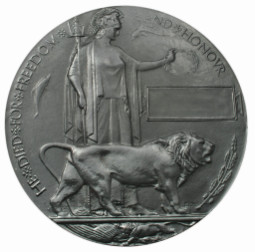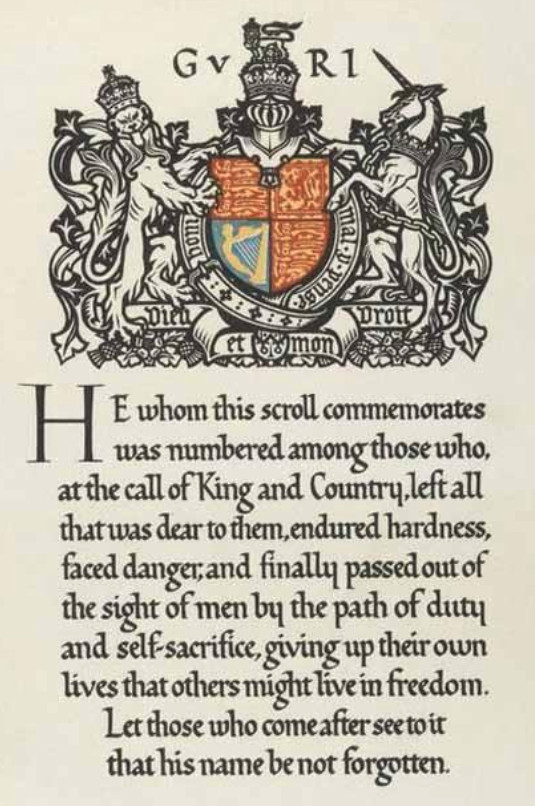Dead Man's Penny

Commemorative Scroll

History of the Dead Man's Penny
In October 1916 the government of the day decided to issue a Memorial Plaque to the next of kin of all men and women in British and Empire forces who died as the result of Great War (World War 1) between 4th August 1914 and 10th January 1920 (for those who died at home, Western Europe or the Dominions) anbd for 30th April 1920 for those who died in any other area and whose cause of death could be directly attributed to the war. (with the except of those who were shot and executed as result of Court Martial. It is estimated that nearly 1,150,000 were issued.
The next of kin would have been notified of the death of their relative, initially by telepgram from the War Office and then they would be sent the memorial plaque in a purpose made cardboard folder.
The Memorial Plaque was made at the Memorial Plaque Factory in Acton at 54-56 Church Road, London W3 and later in the Woolwich Arsenal Munitions factory in south London. Those plaques made in Woolwich contain a WA on the reverse side. It was made from bronze gun metal and was 4.5 inches (12cm) in diameter. It showed Britania and a lion, two dolphins and the emblem of Germany's eagle being ripped to pieces by anothe lion. Below this there was a tablet where the name of the deceased service man would be inscribed and around the edge would be inscribed "He died for freedom and honour" This inscription was changed accordingly if the person was a woman. It should also be noted that no rank was ever put on the plaques because all individual who died gave the same sacrifice - their life - and therefore there was never any distinction made - in death - all men/women were equal.
The design of the plaque was created as the result of a competition and the winner of the competition was Mr Edward Carter Preston (1894-1965) and his initials appear above the foot of the lion.
The plaque became known as the "Dead Man's Penny" or "Death Penny" because it bore a striking resemblence to the penny coin.
Interesting Fact:
The telegrams and letters sent to relatives informing them of the death would usually contain the words "Killed in Action" or "Died of Wounds". The definition is given below.
Killed in Action - meant that the soldier died without receiving any medical attention in any way, shape or form.
Died of Wounds - meant that even if the soldier reached the regimental aid post and then died he was deemed to have died from wounds and not killed in action.
Commemorative Scroll and Letter from The King
Each Memorial Plaque was accompanied by a Scroll and a letter from the King.
At the bottom of the scroll would be the Name and Service the person belonged to. The wording on the scroll as penned by Dr Montague Rhodes James, Provost of King's College Cambridge.
|
Accompanying each Commemorative Plaque would be a scroll and a letter from Buckingham Palace bearinng the facsimile of the King's signature. The King's letter contained the words
" I join with my grateful people |
 |
